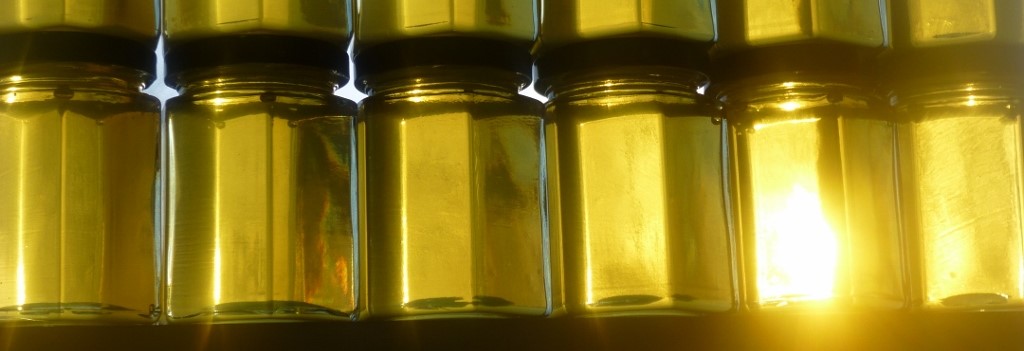I am often asked whether my honey has been heated. The people who ask this want me to tell them that the honey is never heated. Often they ask the question because they are concerned about the enzymes and because they think that heat will destroy the enzymes in honey. They are partly right but enzymes and honey are more robust than people may realise.
What is an enzyme?
Enzymes are large, complex, biochemically active molecules of protein – they could be described as ‘smart’. The names of enzymes always end in an ‘ase’ while the front part of the name gives some indication of action they carry out. Invertase, for example, splits sucrose molecules then inverts the free D-fructose into L-fructose.
What is the nature of enzyme activity
Enzymes are very specific in their activities because they each have specially shaped ‘active sites’ which lock on to certain target molecules and manipulate them in a particular way, or ways, so as to pull them apart. All this takes place spontaneously and is brought about by the changing attractions between constituent molecules in the enzyme and in the target. The act of locking onto the target brings about changes in the enzyme which in turn break or alter the target in some way.
What affects enzyme activity
The rate and/or efficacy of enzyme activity can be affected by chemicals or by temperature or pH or by concentrations of target and/or resultant molecules all of which may change the shape of the active site. Also enzymes each have an optimum temperature at which they perform most effectively and above, or below, which the activity is impaired or reduced.
What happens when heat is applied?
What happens when heat is applied, is the enzyme starts to unravel. If the temperature continues to rise, the shape of the active site is changed or ‘denatured’ and at this point the enzyme is deactivated. However, the deactivation of enzymes by heating is not necessarily permanent and once the temperature falls, the enzyme may return to its original shape and function as normal.
Only if the temperature substantially exceeds the denaturation point and is maintained for some time will the enzyme unravel to such an extent it cannot pull itself together again. At this point the enzyme can be said to be permanently denatured and it will cease to function as a biochemical entity. The temperature tolerance of enzymes is variable.
Honey Enzymes and Temperature Tolerance
Enzymes in honey are of both bee and plant origin and include:
- Invertase which splits the sucrose found in nectars into D-glucose and D-fructose – also known as dextrose and levulose – sugars found in honey. Invertase is added to honey by the bees and its activity is thought to enhance the storage properties of honey by increasing the degree of possible sugar concentration. Invertase is relatively stable to 50 degrees C but the stability varies with the botanical origins of the honey.
- Amylase (alpha and beta) – alpha amylase splits a starch chain randomly into sugars but beta amylase breaks maltose from the ends. Amylases are thought to originate from pollen – its purpose, if any in honey is unknown. Stable to 50 degrees C but degrades gradually over a period of days at this temperature.
- Diastase is a name that is applied to both amylases when its presence in honey is to be assayed as a measure of the amount of heat a honey has been subjected to. It degrades naturally over time but degradation is accelerated at temperatures above 50 degrees C for 5 days. Diastase also deteriorates with storage;
- Glucose oxidase originates in the pharyngeal glands of bees and oxidises glucose to gluconic acid, a by-product of this is hydrogen peroxide which has antibiotic properties. Before this discovery, the observed antibiotic effect was at one time attributed to the action of something named inhibine. Glucose oxidase is stable to 55 degrees C;
- Catalase and phosphatase are also present in honey.
If you are going to eat the honey, the acids in your stomach will denature all the enzymes within seconds.
Click here for Honey Processing
Copyright © Beespoke.info, 2014. All Rights Reserved.
Sources
Babacan, S. and Rand AG. Characterization of honey amylase. J Food Sci. 2007 Jan;72(1):C050-5.
Hooper,T. Guide to Bees and Honey. 1991 Blandford.
Karabournioti,S.and Zervalaki,P. The Effect of Heating on Honey HMF and Invertase. Apiacta, 2001, 36 (4), 177 – 181
Kretavičius, J.; Kurtinaitienė, B.; Račys, J.; Čeksterytė, V. Inactivation of glucose oxidase during heat-treatment de-crystallization of honey. Žemdirbystė (Agriculture) 2010 Vol. 97 No. 4 pp. 115-122
White.J.W. Composition of Honey. In Honey: A Comprehensive Survey. Ed. Eva Crane. Heinemann, London. 1975.

How quickly will these enzymes degrade in a cup of tea at 190-212 F?
Instantly!